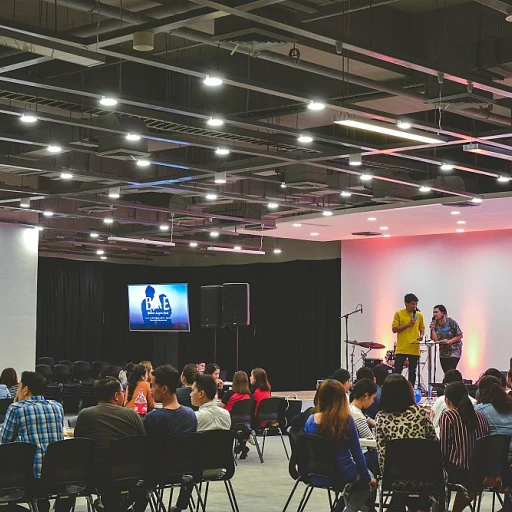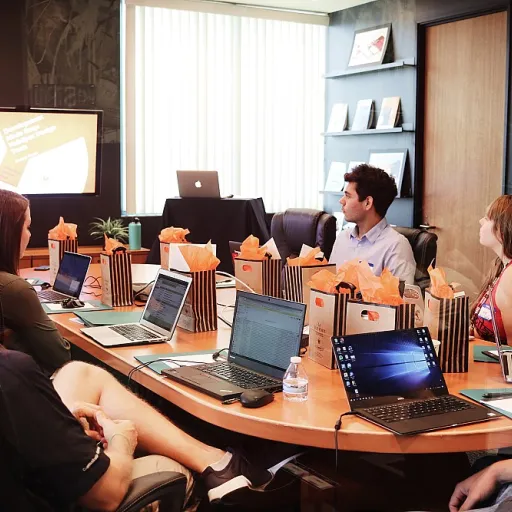
Understanding SIA Staffing
Grasping the Basics of SIA Staffing
In today's ever-evolving job market, grasping the fundamentals of SIA staffing is crucial for any business leader. Staffing Industry Analysts (SIA) represent a critical part of the broader staffing industry, offering insights and trends that help companies navigate the global talent landscape. As businesses seek growth and workforce solutions, understanding SIA staffing becomes paramount. With the workforce continuously transforming, many companies rely on staffing insights to direct their professional endeavors. The staffing market, powered by data and expert analysis, provides a view into how industries are adapting and where future opportunities lie. The industry's focus on both executive and general workforce staffing enables businesses to anticipate changes and make informed decisions. The role of staffing leaders cannot be overstated. They are responsible for driving the market forward, while also advocating for innovative practices such as enhanced employee assessment. To learn more about improving these processes, explore this resource on enhancing employee assessment in candidate sourcing. These insights prove invaluable in cultivating a robust workforce that can adapt and thrive within a constantly shifting landscape. As you delve deeper into SIA staffing, it's essential to understand not only the existing landscape but also the factors contributing to its evolution. Aligning with the strategies and adopting technologies that hold promise will ensure that companies remain competitive in attracting and retaining top talent.Challenges in Candidate Sourcing
Overcoming Barriers in Talent Acquisition
In the ever-evolving landscape of candidate sourcing, the staffing industry faces numerous challenges that require innovative solutions. As businesses vie for top talent in a global market, organizations must adapt to new realities, ensuring their staffing strategies are both efficient and effective.
Addressing Talent Shortages
The rapid growth of industries means that the demand for skilled professionals often outpaces supply. Staffing leaders must learn to navigate these shortfalls by actively expanding their networks and implementing workforce solutions that attract candidates across diverse geographic and professional spectrums. This aspect of executive recruitment is critical as businesses look to fill roles that support their strategic goals and drive growth.
Adapting to Market Changes
Market dynamics can shift rapidly, influenced by technological advancements and changes in economic conditions. Staffing leaders must remain agile, willing to adjust their strategies to accommodate the evolving needs of businesses. This means investing in continuous learning and keeping an eye on workforce trends that may impact future talent pools.
Ensuring Compliance with Privacy Regulations
In today’s data-driven world, adhering to privacy policies and regulations is not optional—it's a must. Organizations must ensure they respect candidates' privacy while maintaining transparent and ethical recruiting practices. Focused staffing approaches that prioritize trust and respect will yield the best results, allowing leaders to build a reputation as responsible workforce solution providers.
Leveraging Insights for Future Staffing Success
As the staffing future unfolds, it will be essential to harness insights gained from current challenges to refine recruitment strategies. By learning from past experiences and analyzing outcomes, staffing leaders can devise more robust methods to predict and plan for talent acquisition needs. A strategic view focused on innovation and adaptability will empower organizations to thrive in even the most competitive talent markets.
For further insights into overcoming these complexities and mastering the art of people leadership in candidate sourcing, you can explore this comprehensive guide.
Strategies for Effective SIA Staffing
Essential Tactics for Streamlining SIA Staffing
In today's fast-paced business environment, ensuring effective SIA staffing requires a tailored, strategic approach. As the industry confronts constant growth and evolution, the predominant themes of the staffing industry revolve around adapting to market needs and refining executive strategies. Here, we share insights on optimizing your sourcing practices:- Leverage Workforce Solutions: Embracing flexible workforce solutions is critical. By utilizing temporary, part-time, or contract staffing, businesses can handle the ebb and flow of demand efficiently. This approach not only fills immediate talent gaps but also addresses long-term executive growth.
- Expand Global Talent Pool: The world is more connected than ever, presenting opportunities to tap into a diverse global talent pool. This strategy empowers staffing leaders to access a wide variety of skills and expertise, matching them with the unique needs of their businesses.
- Power of Professional Networks: Building strong relationships within professional networks strengthens sourcing strategies. Engaging with industry leaders and communities broadens your reach and introduces potential candidates who may not be actively searching for new roles.
- Strategic Use of Technology: Integrating advanced tech solutions into your sourcing process can drastically enhance efficiency. Tools that streamline administrative tasks, enhance candidate assessment, and preserve data privacy are invaluable. This shift toward automated processes allows for a more focused staffing approach which can significantly impact your staffing future.
The Role of Technology in SIA Staffing
Technology's Transformative Potential in Staffing
In the rapidly expanding staffing industry, leveraging technology has become not just beneficial, but essential. Amidst global market fluctuations and evolving business landscapes, the utilization of advanced technological tools empowers staffing professionals to elevate their processes and align with workforce growth dynamics. The "skip main" concern in staffing is often solved by adopting innovative solutions that streamline operational efficiency. Many staffing leaders have noted that by integrating technology, particularly in executive search and talent management, firms can more effectively focus on the main content of their roles – identifying the right candidate for the right position at the right time. Moreover, automation and data analytics are now pivotal in transforming traditional staffing activities. They provide staffing leaders with the power to make informed decisions, minimizing biases and enhancing candidate experience. With workforce solutions increasingly relying on synthetic intelligence, professionals in the staffing industry can refine their tactical insights, transitioning from reactive to proactive candidate sourcing strategies. In the views shared by staffing experts, the privacy policy implications of technology in recruitment cannot be overlooked. Compliance with regulations ensures the ethical handling of sensitive candidate data, fostering trust between staffing agencies and candidates. This aspect is paramount as the industry positions itself for sustainable growth. As staffing executives and vice presidents recognize the potential technology holds, it is vital for strategies to be flexible, allowing for rapid adaptation to changing trends. Continuing education and industry engagement will support business leaders in harnessing these tools, ultimately shaping the future of people staffing and their internal workforce. Preserving the human element while integrating technological advancements will define focused staffing. As professionals look to refine and share content that informs and aids market adaptation, the role of technology will remain a cornerstone in exceptional staffing practices worldwide.Building a Strong Employer Brand
Enhancing Employer Branding in the SIA Staffing Landscape
In the dynamic world of staffing, a company's employer brand plays a critical role in attracting top talent. For SIA staffing, where the focus is often on specific industries or roles, maintaining a strong and appealing brand is vital. Let's delve into key strategies that can bolstering your employer branding efforts. First, the clarity of your market positioning significantly influences how potential candidates view your business. It is essential to communicate not just what your company does, but also how it impacts the global workforce landscape. Companies that share their success stories and executive perspectives on innovation tend to earn their spot as leaders in the staffing industry. Building an employer brand is akin to creating a unique professional identity. Ensure that your main content online reflects your company culture and aligns with your privacy policy to foster trust and transparency. Highlight growth opportunities and emphasize your commitment to workforce solutions, which are key drivers for candidates seeking long-term career options. A focused staffing approach also empowers businesses to stand out. Tailor your branding strategies to engage with specific sectors and roles within the staffing industry. Offering industry-specific insights or sharing content that resonates with potential workforce leaders could be a game-changer. Furthermore, the power of social proof cannot be underestimated. Encourage satisfied clients and placed candidates to share their experiences. Their testimonials not only enhance your credibility but also further position your business as a thought leader. By learning from the market's best practices and continuously innovating, staffing leaders can ensure their brand remains relevant and appealing against the backdrop of staffing future trends.Future Trends in SIA Staffing
Anticipating Shifts in the Staffing Landscape
The staffing industry is poised to undergo significant transformation as market dynamics continue to evolve. The focus on workforce solutions is intensifying, and leaders are keen on exploring innovative strategies to address the complexities in candidate sourcing. As businesses navigate through these changes, it is essential to share a forward-thinking view, aligning with global trends and workforce demands.
Several factors are driving growth and change in the staffing sector. Economic shifts, technological advancements, and changing work preferences contribute to this evolving landscape. Staffing leaders are expected to harness the power of technology to facilitate efficient sourcing and engagement of talent. Moreover, privacy policy considerations are becoming increasingly vital as businesses strive to maintain trust and compliance while managing their global workforce.
Executive insights suggest that the staffing industry will continue to see a blend of human touch and technology-driven solutions in candidate sourcing. Professionals are urged to learn from current trends, ensuring their strategies are adaptable to future changes. As vice presidents and other senior executives strategize for the future, the notion of a shared, inclusive workforce remains a key agenda.
Furthermore, focused staffing initiatives are set to refine how organizations engage with talent. The importance of building robust employer brands has been underscored throughout the industry. By understanding these shifts, staffing leaders can position their organizations for long-term success, embracing transformative solutions that cater to an ever-evolving market.












